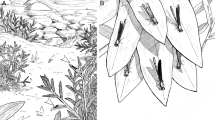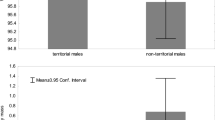Abstract
Alternative reproductive tactics (ARTs) evolve to maximise fitness by favouring alternative phenotypes when high variance in relative fitness occurs amongst individuals. In the damselfly Hetaerina vulnerata males occur as either territorial or nonterritorial, depending on whether males acquire and defend an area to which females are attracted for copulation. Territorial males are usually larger, more pigmented and more successful in obtaining copulations than nonterritorial males. Several studies further suggest that territorial males are in overall better condition than nonterritorial ones. Other studies have investigated whether wing pigmentation, a sexual trait in damselflies, scales hyperallometrically with body size, and asked whether this pattern is related to fitness—nonetheless, a clear answer to this question remains elusive. Here we investigate whether i) territorial and nonterritorial males differed in body size and wing pigmentation; ii) body size, wing pigmentation and/or male status (male ART) predicted male mating success; and iii) the allometry of wing pigmentation in territorial and nonterritorial males, and amongst mated and unmated males. We first found that territorial and nonterritorial males did not differ in body size. Second, contrary to what occurs in other damselflies, territorial and nonterritorial males exhibited similar amounts of wing pigmentation. Third, only territory tenure, but not body size or wing pigmentation, predicted male mating success. Finally, with the exception of the relationship exhibited by mated males, which exhibited isometry, wing pigmentation was hyperallometric in all groups of males tested. The latter result suggests that hyperallometry of the sexual trait in this damselfly may not be selectively advantageous.



Similar content being viewed by others
References
Álvarez HA, Serrano-Meneses MA, Reyes-Márquez I, Jiménez-Cortés JG, Córdoba-Aguilar A (2013) Allometry of a sexual trait in relation to diet experience and alternative mating tactics in two rubyspot damselflies (Calopterygidae: Hetaerina). Biol J Linn Soc 108:521–533
Andersson M (1994) Sexual selection. Princeton University Press, New Jersey
Beck ML, Pruett-Jones S (2002) Fluctuating asymmetry, sexual selection, and survivorship in male dark-winged damselflies. Ethology 108:779–791
Bello-Bedoy R, González-Santoyo I, Serrano-Meneses MA, Vrech D, Rivas M, Munguía-Steyer R, Córdoba-Aguilar A (2015) Is allometry of sexual traits adaptive? A field test with territorial damselflies. Biol J Linn Soc 114:327–334
Blanckenhorn WU, Preziosi RF, Fairbairn DJ (1995) Time and energy constraints and the evolution of sexual size dimorphism: to eat or to mate? Evol Ecol 9:369–381
Bonduriansky R (2007) Sexual selection and allometry: a critical reappraisal of the evidence and ideas. Evolution 61:838–849
Bonduriansky R, Day T (2003) The evolution of static allometry in sexually selected traits. Evolution 57:2450–2458
Contreras-Garduño J, Canales-Lazcano J, Córdoba-Aguilar A (2006a) Wing pigmentation, immune ability, fat reserves and territorial status in males of the rubyspot damselfly, Hetaerina americana. J Ethol 24:165–173
Contreras-Garduño J, Lanz-Mendoza H, Córdoba-Aguilar A (2006b) The expression of a sexually selected trait correlates with different immune defense components and survival in males of the American rubyspot. J Insect Physiol 53:612–621
Contreras-Garduño J, Buzatto B, Serrano-Meneses MA, Nájera-Cordero K, Córdoba-Aguilar A (2008) The size of the red wing spot as a heightened condition dependent trait in the American rubyspot. Behav Ecol 19:724–732
Corbet PS (1963) A biology of dragonflies. Quadrangle Books, Chicago
Cordero Rivera A, Egido Pérez FJ (1998) Mating frequency, population density and female polychromatism in the damselfly Ischnura graellsii: an analysis of four natural populations. Etología 6:61–67
Córdoba-Aguilar A (1994) Male substrate use in relation to age and size in Hetaerina cruentata (Rambur) (Zygoptera: Calopterygidae). Odonatologica 23:399–403
Córdoba-Aguilar A (2002) Wing pigmentation in territorial male damselflies, Calopteryx haemorrhoidalis: a possible relation to sexual selection. Anim Behav 63:759–766
Córdoba-Aguilar A, Cordero-Rivera A (2005) Evolution and ecology of Calopterygidae (Zygoptera: Odonata): status of knowledge and research perspectives. Neotrop Entomol 34:861–879
Córdoba-Aguilar A, Lesher-Treviño AC, Anderson CN (2007) Sexual selection in Hetaerina titia males: a possible key species to understand the evolution of pigmentation in calopterygid damselflies (Odonata: Zygoptera). Behaviour 144:931–952
Córdoba-Aguilar A, Jiménez-Cortés JG, Lanz-Mendoza H (2009) Seasonal variation in ornament expression, body size, energetic reserves, immune response, and survival in males of a territorial insect. Ecol Entomol 34:228–239
R Core Team (2014) R: a language and environment for statistical computing. R Foundation for Statistical Computing, Vienna, Austria. URL http://www.R-project.org/
Crowley PH, Johansson F (2002) Sexual dimorphism in Odonata: age, size and sex ratio at emergence. Oikos 96:364–378
Darwin C (1871) The descent of man and selection in relation to sex. John Murray, London
Emlen DJ (1997) Alternative reproductive tactics and male-dimorphism in the horned beetle Ontophagus acuminatus (Coleoptera: Scarabaeidae). Behav Ecol Sociobiol 41:335–341
Fairbairn DJ (1997) Allometry for sexual size dimorphism: pattern and process in the coevolution of body size in males and females. Annu Rev Ecol Syst 28:659–687
Forsyth A, Montgomerie RD (1987) Alternative reproductive tactics in the territorial damselfly Calopteryx maculata: sneaking by older males. Behav Ecol Sociobiol 21:73–81
González-Santoyo I, Córdoba-Aguilar A, González-Tokman DM, Lanz-Mendoza H (2010) Phenoloxidase activity and melanization do not always covary with sexual trait expression in Hetaerina damselflies (Insecta: Calopterygidae). Behaviour 147:1285–1307
Grether GF (1996a) Intrasexual competition alone favors a sexually dimorphic ornament in the rubyspot damselfly Hetaerina americana. Evolution 50:1949–1957
Grether GF (1996b) Sexual selection and survival selection on wing coloration and body size in the rubyspot damselfly Hetaerina americana. Evolution 50:1939–1948
Grether GF (1997) Survival cost of an intrasexually selected ornament in a damselfly. P Roy Soc Lond B Biol 264:207–210
Grether GF, Grey RM (1996) Novel cost of a sexually selected trait in the rubyspot damselfly Hetaerina americana: conspicuousness to prey. Behav Ecol 7:465–473
Gross MR (1996) Alternative reproductive strategies and tactics: diversity within sexes. Trends Ecol Evol 11:92–98
Kodric-Brown A, Sibly RM, Brown JH (2006) The allometry of ornaments and weapons. Proc Natl Acad Sci U S A 103:8733–8738
Koskimäki J, Rantala MJ, Taskinen J, Tynkkynen K, Suhonen J (2004) Immunocompetence and resource holding potential in the damselfly, Calopteryx virgo L. Behav Ecol 15:169–173
Koskimäki J, Rantala MJ, Suhonen J (2009) Wandering males are smaller than territorial males in the damselfly Calopteryx virgo (L.) (Zygoptera: Calopterygidae). Odonatologica 38:159–165
Lefevre KL, Muehter VR (2004) Competition for mating resources in a territorial damselfly (Odonata: Calopterygidae). Stud Neotrop Fauna E 39:159–165
Marden JH, Waage JK (1990) Escalated damselfly territorial contests are energetic wars of attrition. Anim Behav 39:954–959
Nomakuchi S, Higashi K, Harada M, Maeda M (1984) An experimental study of territoriality in Mnais pruinosa pruinosa Selys (Zygoptera: Calopterygidae). Odonatologica 13:259–267
Plaistow S, Siva-Jothy MT (1996) Energetic constraints and male mate securing tactics in the damselfly Calopteryx splendens xanthostoma (Charpentier). P Roy Soc Lond B Biol 263:1233–1238
Plaistow SJ, Tsubaki Y (2000) A selective trade-off for territoriality and non-territoriality in the polymorphic damselfly Mnais costalis. P Roy Soc Lond B Biol 267:969–975
Raihani G, Serrano-Meneses MA, Córdoba-Aguilar A (2008) Male mating tactics in the American rubyspot damselfly: territoriality, nonterritoriality and switching behaviour. Anim Behav 75:1851–1860
Rantala MJ, Honkavaara J, Dunn DW, Suhonen J (2011) Predation selects for increased immune function in male damselflies, Calopteryx splendens. P Roy Soc Lond B Biol 278:1231–1238
Romo-Beltrán A, Macías-Ordóñez R, Córdoba-Aguilar A (2009) Male dimorphism, territoriality and mating success in the tropical damselfly, Paraphlebia zoe Selys (Odonata: Megapodagrionidae). Evol Ecol 23:699–709
Serrano-Meneses MA, Córdoba-Aguilar A, Méndez V, Layen S, Székely T (2007) Sexual size dimorphism in the American rubyspot: male body size predicts male competition and mating success. Anim Behav 73:987–997
Shuster SM, Wade MJ (2003) Mating system and strategies. Princeton University Press, New Jersey
Siva-Jothy M (1999) Male wing pigmentation may affect reproductive success via female choice in a calopterygid damselfly (Zygoptera). Behaviour 136:1365–1377
Sokal RR, Rohlf FJ (2012) Biometry: the principles and practice of statistics in biological research, 4th edn. Freeman, San Francisco
Strobbe F, Stoks R (2004) Life history reaction norms to time constraints in a damselfly: differential effects on size and mass. Biol J Linn Soc 83:187–196
Suhonen J, Rantala MJ, Honkavaara J (2008) Territoriality in odonates. In: Córdoba-Aguilar A (ed) Dragonflies and damselflies: model organisms for ecological and evolutionary research. Oxford University Press, Oxford, pp 203–217
Svensson EI, Friberg M (2007) Selective predation on wing morphology in sympatric damselflies. Am Nat 170:101–112
Taborsky M, Brockmann HJ (2010) Alternative reproductive tactics and life history phenotypes. In: Kappeler PM (ed) Animal behaviour: evolution and mechanisms. Springer, Heidelberg, pp 537–586
Taborsky M, Oliveira RF, Brockmann HJ (2008) The evolution of alternative reproductive tactics: concepts and questions. In: Oliveira RF, Taborsky M, Brockmann HJ (eds) Alternative reproductive tactics: an integrative approach. Cambridge University Press, New York, pp 1–21
Thornhill R, Alcock J (1983) The evolution of insect mating systems. Harvard University Press, Cambridge
Tsubaki Y, Hooper RE, Siva-Jothy MT (1997) Differences in adult and reproductive lifespan in the two male forms of Mnais pruinosa costalis Selys (Odonata: Calopterygidae). Res Popul Ecol 39:149–155
Tynkkynen K, Kotiaho JS, Luojumäki M, Suhonen J (2006) Interspecific territoriality in Calopteryx damselflies: the role of secondary sexual characters. Anim Behav 71:299–306
Warton DI, Wright IJ, Falster DS, Westoby M (2006) Bivariate line-fitting methods for allometry. Biol Rev 81:259–291
Warton DI, Duursma RA, Falster DS, Taskinen S (2012) SMATR 3 – an R package for estimation and inference about allometric lines. Methods Ecol Evol 3:257–259
Acknowledgments
J. R.-D. was supported by a) the multilateral agreement RUDECOLOMBIA between the Universidad del Quindío (Colombia) and the Benemérita Universidad Autónoma de Puebla (México), which provided her with the Movilidad Académica Estudiantil grant (oficio número 3201/DGRIIA/2012), and b) an MSc scholarship from the Consejo Nacional de Ciencia y Tecnología (CONACYT, México; registro de beca 627278). K. L.-G. was supported by a Postdoctoral Fellowship from CONACYT (México; CVU 265483). This work was supported by CACyPI-UATx-2015, Universidad Autónoma de Tlaxcala. M. A. S.-M. was supported by the Posgrado en Ciencias Biológicas, Universidad Autónoma de Tlaxcala. Fieldwork was greatly assisted by Hugo A. Álvarez and Isidora Reyes Márquez. We finally thank two anonymous reviewers for the comments and suggestions provided on earlier versions of this MS, which greatly improved its quality.
Author information
Authors and Affiliations
Corresponding author
Ethics declarations
Conflict of Interest
The authors declare that they have no conflict of interest.
Rights and permissions
About this article
Cite this article
Ramírez-Delgado, J., López-García, K., Lara, C. et al. Wing Pigmentation in Males of a Territorial Damselfly: Alternative Reproductive Tactics, Allometry and Mating Success. J Insect Behav 28, 569–581 (2015). https://doi.org/10.1007/s10905-015-9528-y
Revised:
Accepted:
Published:
Issue Date:
DOI: https://doi.org/10.1007/s10905-015-9528-y




